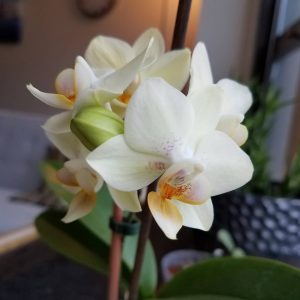
My office has a lot of orchids. Two offices ago, I got two small ones as a gift to myself upon moving in. My current office has so much more light and window ledge space, and the old orchids were growing so happily here – even producing new blooms! – that I acquired a few more. Then I noticed some sad ones on the clearance rack at Lowes, and some neglected ones in need of repotting at a friend’s house.
My windowsill is just about maxed out with these plants in various stages of life. One of the sad clearance rack ones turned out to be incredibly robust and continues to hang onto two of three blooms its had since February. One, a striking deep purple that was in full bloom at the same time the clearance one was clinging to life, quickly lost its flowers and has gradually dropped every single leaf it had when I bought it. I repotted it, removing the dead roots and rotted substrate and giving it a nice airy new pot, but it only seemed to accelerate the leaf loss. Mournful, I moved it to a less-prominent spot in the window. Honestly, I was concerned that its haggard appearance would interfere with the peaceful tone I try to create in my office. During the last few weeks, to my surprise, it has produced a beautiful new leaf! Not nearly as big as the one that is still dying off by its side, but new and healthy and full of promise.
My most recent orchid addition was by far the most dazzling: purple and yellow flowers tumbled down a gracefully curved flower spike. A few patients were reminded of a tiger. I thought of dragons. This week its last two blooms, wilted and muted in color, clung sadly to the end of the spike. A patient noticed and asked “What will it do now? Will it flower again?”

Dragon-tiger orchid in full bloom!
Of course I have the same question, and perhaps we shared the same wish that it would. I replied that it might or might not, but it would likely take some time. Orchids grow roots and new leaves during the summer and, if conditions are right, may bloom fall to spring. But of course I’ve heard lots of people say they could never manage to get an orchid to rebloom. My original orchids went more than a year without reblooming, and one of them still hasn’t.
I joked with my patient that growing orchids was a metaphor for therapy. Initially I meant this in a wry, self-deprecating way. We have worked together for a long time and have talked about how frustrating it can be when change comes very slowly, or not at all.
As I’ve learned more about orchids, though, I’ve learned how to notice small changes that indicate their health and happiness. I do feel concerned when a leaf starts to shrivel or discolor and I worry that I’ve done something wrong. At the same time, I know other indicators of growth to look for; I can notice the health of the roots and, if I’m lucky, spot new roots emerging that will make the plant stronger. If I can see new leaves emerging I know the conditions are right for the plant to continue to grow. Blooms are beautiful, and I’m delighted when they appear, but one of the oldest orchids that has never bloomed since I bought it is now bursting with new roots and leaves – really, it looks as if it’s jumping up out of its pot! There is no doubt that plant is healthy, even if it doesn’t have flowers.
This is the fuller, non-sarcastic metaphor for therapy. Progress is not always linear. Small steps are important and worth celebrating. Growth and thriving might look different from case to case, and sometimes thriving is not showy.
Therapists and patients can forget these points and grow disheartened, frustrated, or anxious. Life comes with setbacks, and one of the most powerful things a therapist can do is hold for themselves and their patients the conviction that one can emerge from even devastating losses. We can do that in part by making space to notice small steps toward change – tiny efforts to reach for what one needs. As therapists and as patients, we can be mindful that therapeutic growth might look different from one person to another and to remember that there is not one picture of health or happiness. It may be gratifying when a patient ‘blooms’ – whatever that means in my imaginary notion of the ‘good life’ – but therapy is not about making people become more pleasing to the therapist. Sometimes, even for the patient themselves, therapy becomes about recognizing other kinds of growth or health. Sometimes our image of the good life changes, and we recognize a new kind of beauty.